Project wheel-tracked tank A-20
Even before the end of the war in Spain, the Soviet military and designers began to discuss the appearance of a promising tank. The rapid development of anti-tank artillery led to the emergence of a requirement to equip machines with anti-bullet armor resistant for 37 and 45 caliber guns. There were common views on the armament of promising tanks. The reason for numerous disputes was the chassis. The specialists divided into two camps, which defended the need to use a tracked or combined propulsion unit.
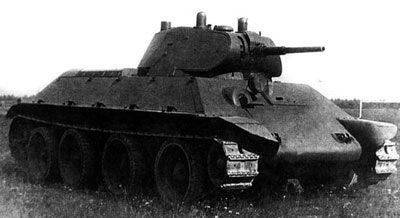
Experienced A-20
The main prerequisite for the creation of wheeled-tracked tanks was the low resource of the tracks that existed at that time. The military wanted a tracked drive with a resource of at least 3000 km. In this case, it was possible to abandon the idea of hauling equipment over long distances using wheels. The lack of required tracks was an argument in favor of a combined propulsion unit. At the same time, the wheel-tracked scheme complicated the design of the tank, and also had a negative impact on production and operation. In addition, foreign countries by this time began the transition to a full-fledged tracked vehicles.
October 13 1937, the Kharkov Locomotive Plant them. Comintern (KhPZ) received a technical task for the development of a new wheeled-tracked tank. This machine was supposed to have six pairs of drive wheels, combat weight at the level of 13-14 t, antislite armor with inclined arrangement of sheets, as well as 45-mm cannon in a rotating turret and several machine guns. The project received the designation BT-20.
In March, 1938, Commissar of Defense K.E. Voroshilov made a proposal concerning the future of armored units. In a memo addressed to the chairman of the Council of People's Commissars, he noted that tank units needed only one tank. To determine the most profitable version of such a machine, the People's Commissar proposed to develop two similar projects of tanks with different propulsion units. Having the same protection and armament, the new tanks were to be equipped with wheel-tracked and tracked propellers.
By September 1938, Kharkov engineers had completed the development of the BT-20 project and presented it to the specialists of the People's Commissariat of Defense. The staff of the Armored Directorate reviewed the project and approved it, making some suggestions. In particular, it was proposed to develop a version of the tank with the 76-mm gun, to provide for the possibility of circular observation from the tower without using viewing devices, etc.
Further work was carried out taking into account the proposals of the ABTU. Already in October, 38-th KhPZ presented a set of drawings and models of two promising medium tanks, which differed in the type of running gear. The main military council examined the documentation and models in early December of the same year. Soon, the preparation of working drawings for a wheeled-tracked tank began, by which time it had received the new designation A-20. In addition, the design of the tracked vehicle called A-20G was launched. In the future, this project will receive its own name A-32. The lead engineer of both projects was A.A. Morozov.
At this stage of the implementation of the two projects, serious disagreements arose. In the fall of 38, the military agreed on the need to build and test two experimental tanks. However, at a meeting of the 27 Defense Committee in February 1939, the representatives of the Defense Commissariat subjected the A-32 tracked tank to serious criticism. The wheel-tracked A-20, as it was then thought, had greater operational mobility. In addition, the current status of the project A-32 left much to be desired. As a result, doubts arose about the need to build and test a tracked vehicle.
However, the chief designer of KhPZ M.I. Koshkin insisted on the need to build two prototypes. According to various sources, the military offered to close project A-32 due to the impossibility of quickly completing its development and building a prototype within an acceptable timeframe. However, M.I. Koshkin was able to convince them of the need to continue the work and, as it turned out, he was right. In the future, the A-32 after the mass of improvements was adopted under the symbol T-34. The medium tank T-34 was one of the most successful combat vehicles of the Great Patriotic War.
Tank A-20 in a number of ways lost to its caterpillar counterpart, however, it is of great interest with technical and historical points of view. So, he became the last wheeled and tracked tank of the Soviet Union. In the future, the problem of unacceptably high wear of the tracks was solved and abandoned the combined chassis.
Medium tank A-20 was built on the classic layout. In front of the armored hull there was a driver (at the left side) and an arrow. Behind them there was a fighting compartment with a tower. Stern hull given under the engine and transmission units. The tower provided for jobs commander and gunner. The commander of the car also performed the duties of the loader.
The armored vehicle had a welded construction. It was proposed to collect from several armor sheets with a thickness of 16-20 mm. To increase the level of protection, the hull sheets were located at an angle to the vertical: the front sheet — under 56 °, the sides — 35 °, and the aft — 45 °. The welded tower was made of sheets with a thickness of up to 25 mm.
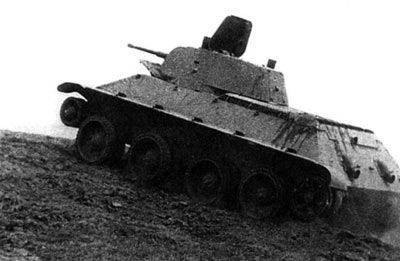
Reservations with a thickness of up to 25 mm, located at rational angles, made it possible to provide protection against bullets of large-caliber small weapons and small-caliber artillery, as well as to maintain the combat weight of the machine at the level of 18 t.
At the rear of the hull there was a B-2 diesel engine with 500 horsepower. The transmission consisted of a four-stage three-speed gearbox, two side clutches and two single-row final drives. The use of wheel-track propulsion impacted the design of the transmission. For the movement on the tracks, the machine had to use the drive wheels with a ridge engagement located in the stern. In the wheel configuration, three rear pairs of road wheels became the driving wheels. An interesting fact is that the BT-20M armored vehicles were widely used as part of the transmission of the A-7 tank.
The chassis of the medium tank A-20 had four support rollers on board. In the front part of the hull, the guide wheels were mounted, in the aft - leading wheels. Basic skating rinks were equipped with an individual spring suspension. Three rear pairs of rollers were associated with the transmission and were leading. The two front wheels had a turning mechanism to control the vehicle when driving “on wheels”.
In the turret of the tank installed 45-mm tank gun 20-K. Inside the fighting compartment, we managed to place an 152 projectile for the cannon. In one installation with a gun mounted twin machine gun DT caliber 7,62 mm. One more machine gun of the same type was in spherical installation of a frontal sheet of the body. The total ammunition of two machine guns - 2709 cartridges.
A-20 tank gunner had a telescopic and periscopic sights. Mechanisms with electric and manual drives were used to target the gun. The commander of the vehicle could monitor the situation on the battlefield with his own panorama.
Communication with other tanks and units was provided with the help of 71-TK radio station. The crew of the car was supposed to use the TPU-2 tank intercom.
At the beginning of the summer of 1939, Plant No. 183 (a new name for KhPZ) completed the construction of two experimental tanks A-20 and A-32. The wheel-tracked vehicle was handed over to the military representative office of ABTU 15 June 39. Two days later, the military handed over the second experienced tank. After some preliminary checks on 18 July, comparative field tests of the new tank started, which continued until August 23.
Medium tank A-20 showed quite high performance. On a wheeled course, he developed speeds up to 75 km / h. The maximum speed on the tracks on a dirt road reached 55-57 km / h. When driving on a highway, the range was 400 km. The car could climb the 39-degree slope and wade through water obstacles to a depth of 1,5 m. During the tests, the prototype A-20 passed along different 4500 km routes.
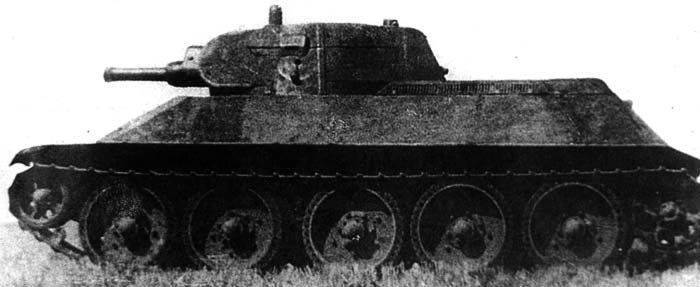
Experienced A-32
The test report stated that the A-20 and A-32 tanks presented surpass all existing serial vehicles in a number of characteristics. In particular, there was a significant increase in the level of protection in comparison with old equipment. It was argued that rational angle of armor and other design features provide greater resistance to shells, grenades and flammable liquids. The crossover of the A-20 and A-32 was superior to the existing BT series tanks.
The commission that conducted the tests concluded that both tanks met the requirements of the Defense Commissariat, so that they could be put into service. In addition, the commission made a proposal concerning the design of the tank A-32. This machine, which had a certain margin for weight gain, after minor modifications could be equipped with more powerful armor. Finally, the report pointed out some of the shortcomings of the new armored vehicles that needed to be addressed.
New tanks were compared not only with serial, but also with each other. During the tests, some advantages of A-20 in terms of mobility were found out. This machine has proven its ability to make long marches with any undercarriage configuration. In addition, the A-20 retained the desired mobility with the loss of tracks or damage to two road wheels. However, there were drawbacks. The A-20 was inferior to the tracked A-32 in terms of firepower and protection. In addition, the wheeled-tracked tank had no reserves for modernization. His chassis was heavily loaded, because of which, with any noticeable modifications to the car, it would have to be developed anew.
19 September 1939, the People's Commissariat of Defense made a proposal to adopt two new medium tanks for the Red Army. Before starting the assembly of the first production machines, the designers of the plant # XXUMX recommended fixing the identified deficiencies, as well as slightly changing the design of the hull. The front sheet of the hull should now have a thickness of 183 mm, the front part of the bottom - 25 mm.
By December 1, 1939 was required to build an experimental batch of A-32 tanks. The design of the first ten machines planned to make some adjustments (project A-34). A month later, Kharkov specialists had to transfer to the military the first 10 tanks A-20, also in a modified version. Full-scale mass production of A-20 was supposed to begin with 1 March 1940 of the year. The annual release plan was set at the level of 2500 tanks. The assembly of new tanks was to be carried out by the Kharkov plant No. XXUMX. Production of armor parts were going to entrust the Mariupol Metallurgical Plant.
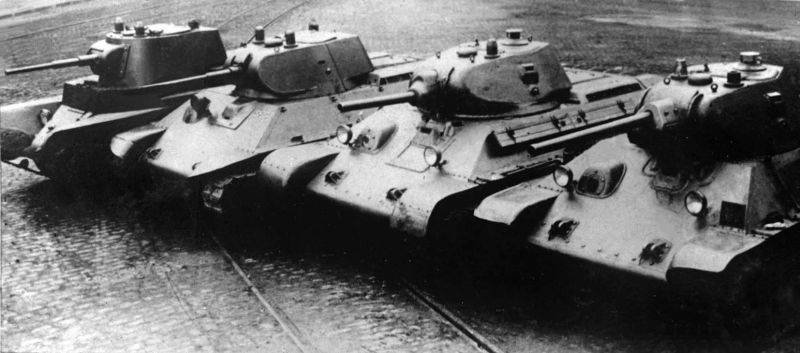
Experienced tanks at the site in Kubinka. From left to right: BT-7M, A-20, T-34 arr. 1940, T-34 arr. 1941
The development of the updated project A-20 has been delayed. Kharkiv plant was loaded with orders, because of which the creation of a modernized project was associated with certain difficulties. New design work began in November 1939. It was planned to test the upgraded A-20 with enhanced armor and undercarriage at the very beginning of 40. Soberly assessing its capabilities, Plant No. 183 appealed to the management of the industry with a request to transfer the serial production of А-20 to another company. Kharkov plant could not cope with the full-scale production of two tanks at the same time.
According to some reports, work on the A-20 project continued until the spring of 1940. Plant No.183 had certain plans for this project, and also wished to transfer the construction of serial tanks to another enterprise. Apparently, those wishing to start the production of new medium tanks were not found. In June, the Politburo of the CPSU (B) issued a decree of 1940, in accordance with which it was required to begin mass production of medium-sized T-34 tanks (former A-32 / 34) and heavy KVs. Tank A-20 in the series did not go.
There is some information about the further fate of the only built experienced tank A-20. At the beginning of World War II, this machine was included in the tank company of Semyonov, which, according to some sources, was formed from the equipment available at the test site of the 22 th Scientific test vehicle and armored range (now 38 th Research Institute of the Ministry of Defense, Kubinka). In the middle of November, the X-NUMX prototype A-1941 completed the 20-th tank brigade. December 22 car received minor damage and after a few days returned to service. For several weeks the 1 Brigade carried out combat missions together with the cavalry of Major-General L.М. Dovatora. In mid-December, the A-22 tank was again damaged, after which it was relegated to the rear for repair. At this traces of an experienced car are lost. Her further fate is unknown.
Medium tank A-20 did not go into the series. Nevertheless, its development, construction and testing were of great importance for the domestic tank building. Despite the not quite successful completion, this project helped to establish real prospects for tracked and wheeled-tracked vehicles. Tests of A-20 and A-32 tanks showed that with existing technologies, armored vehicles with a combined undercarriage are rapidly losing advantages over tracked vehicles, but cannot get rid of congenital defects. In addition, A-32 had a certain stock of characteristics for upgrading. As a result, the updated A-32 tank went into series, and the A-20 did not leave the test and refinement stage, becoming the last Soviet wheeled-tracked tank.
On the materials of the sites:
http://armor.kiev.ua/
http://opoccuu.com/
http://bronetehnika.narod.ru/
http://tankinfo.ru/
http://btvt.narod.ru/
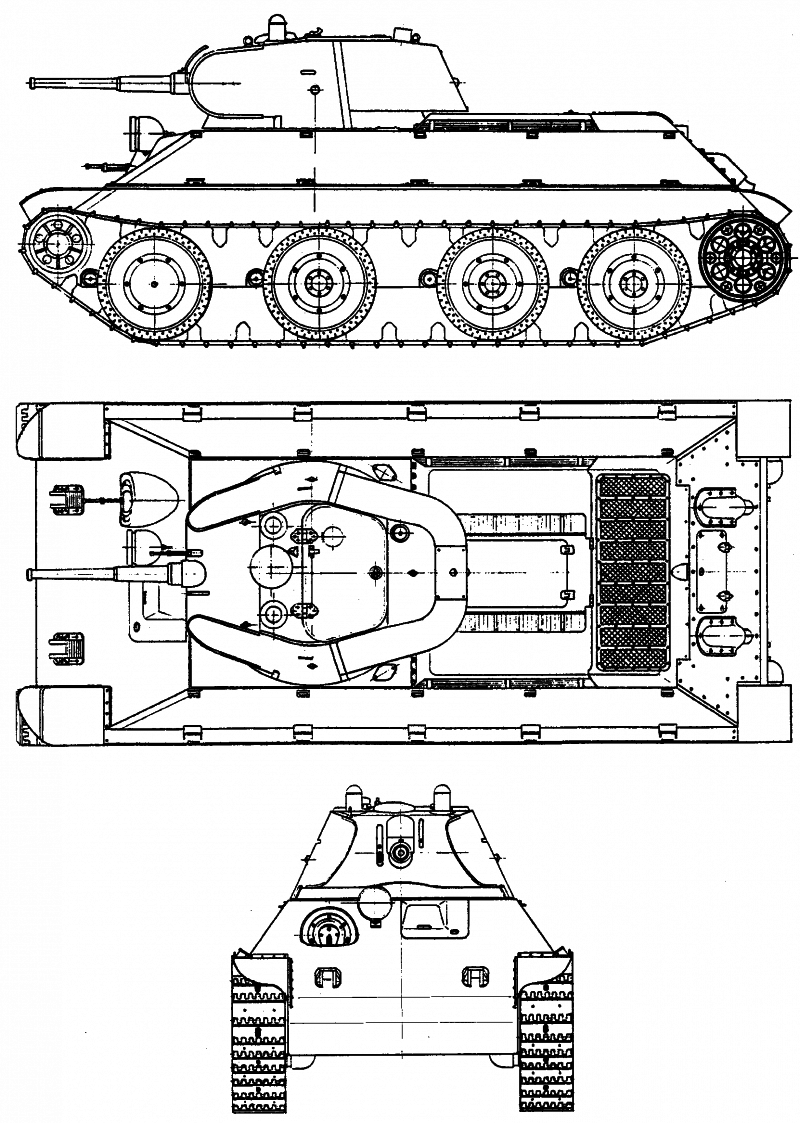
Information